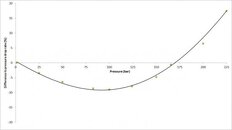There are more variables than mentioned... but you have identified that gas compressibility (van der waals equation) can have a significant effect.
Almost without exception, experience tells us that a diver in a low or no-flow cave will use a greater volume of gas on the way in than on the way out. Factors that contribute include:
Drop in temperature since water is often cooler than ambient air.
Rate of breathing. Most divers are more stressed at the beginning of a dive than at the end
Auxiliary consumption (wing/drysuit etc.) is greater when dive begins... a generalization but certainly the case in majority of instances
Two factors that many divers fail to account for are: Gas compressibility, non-calibrated gauges.
Therefore, my seat-of-the-pants, pull a number outta your arse guess would be gauge drop pressure upon exit would be about 10 percent less than expected.
Almost without exception, experience tells us that a diver in a low or no-flow cave will use a greater volume of gas on the way in than on the way out. Factors that contribute include:
Drop in temperature since water is often cooler than ambient air.
Rate of breathing. Most divers are more stressed at the beginning of a dive than at the end
Auxiliary consumption (wing/drysuit etc.) is greater when dive begins... a generalization but certainly the case in majority of instances
Two factors that many divers fail to account for are: Gas compressibility, non-calibrated gauges.
Therefore, my seat-of-the-pants, pull a number outta your arse guess would be gauge drop pressure upon exit would be about 10 percent less than expected.





